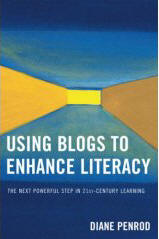 Penrod, D. (2007). Using
blogs to enhance literacy: The next powerful step in 21st-century
learning. Lanham, Maryland, Toronto: Plymouth, UK: Rowman & Littlefield
Education. 188 pp, ISBN 1578865662
Penrod, D. (2007). Using
blogs to enhance literacy: The next powerful step in 21st-century
learning. Lanham, Maryland, Toronto: Plymouth, UK: Rowman & Littlefield
Education. 188 pp, ISBN 1578865662
Overview
With the growth of
technology, everyone can have his or her own web log (blog). Everyone can
create one in a very short time. Considering the rapid growth and use of blogs,
adolescents spend more and more time logged onto the Internet. As educators,
parents, and bloggers, we have to rethink blogs' powerful influence on people's
communication, teachers' teaching and students' learning. The book Using Blogs
to Enhance Literacy: The Next Powerful Step in 21st-Century Learning not only
discusses current issues of blogging but also helps readers to understand the
application of blogs in different aspects. The author, Diane Penrod (2007) wrote this
book because she has seen the integration of technology and blogging in her
writing class. She has seen the powerful influence of blogging phenomenon;
therefore, readers are able to read her work to understand the application of
blog use on learning and current issues raised on use of blogs.
In this book, Penrod explicitly teaches readers how blogs improve literacy
learning and addresses the issues that have been raised among the bloggers. The
book includes ten chapters, including blogging and new literacies, blogs as a
new writing genre, encouraging safe blogging practices, and creating classroom
ethnic for blogging In this book review, I will elaborate how blogs have
extended their use from entertainment to learning literacy. Second, the review
summarizes the author's viewpoints and illustrates suggestions on how to apply
blogs to literacy learning.
Penrod also illustrates
the relationship among gender, identity, and blogging bullying. First,
the book provides an overview of males’ and females’ blogging styles. She
compares boys’ and girls’ reading and writing styles on the blogs. The
differences imply that teachers and parents can understand how teenagers try to
identify themselves. Gender differences in blogging also encourage females to
read and write, particularly those who are from a society or culture that does
not encourage women to receive higher education. In the process of building a
blog, students are also building their identity with the function of anonymity.
The author also already elaborates on the potential use on learning, and blogs
can help learners to achieve the goal of cooperative learning. Penrod finally
discusses blogging bullying. Examples of Ryan Halligan, Gyyslain Raza, and
Wiiliam Freund show that content of their blogs could reflect the students’
reality when they are bullied at school. Parents and teachers cannot ignore the
power of blogs to understand their children, especially their internal thoughts.
A related issue is the safety of blogging, so the author discusses how to
develop students’ skills and to use appropriate language for learning and
expressing themselves. Censorship is not the best way to prevent misbehavior in
the blogging; on the other hand, parents and teachers should be involved and
motivate students to learn their responsibility as a blogger. Knowing the
ethics of proper blogging is a lesson that all bloggers should know. When applying
blogging in the classroom, Chapter 9 provides lists of ethical codes to teach
bloggers how to use respectful language, how to protect personal information
without revealing themselves in public, or how to judge things in a positive
way with integrity.
This book is the most
updated discussion of blogging and learning at school for adolescents. The book
points out the powerful pervasive use of blogging and potential benefits to
learning. In addition, it provides examples to support how blogging helps
students, teenagers, and minority groups to establish
their identities, have their voices heard, and have more access to interact
with other online community groups. The book also considers potential problems
with blogging and offers guidelines for readers. After reading this work, I
feel that the argument is presented in a logical way, strongly supported by
examples and research. The audience of this book can range from students,
teachers, and parents to all bloggers.